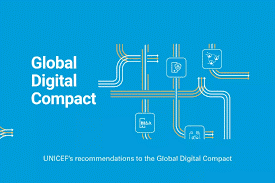Global Digital Compact (GDC): Advancing Digital Innovation for Sustainable Development
Syllabus:
- GS – 3 – Sustainable development , Inclusive growth , Innovation , Digital India Mission
Why in News
- The Global Digital Compact (GDC) is in the news following its adoption at the UN’s Summit of the Future, aiming to regulate digital technologies and advance global cooperation for sustainable development.
Focus :
This article delves into the Global Digital Compact (GDC), an ambitious diplomatic instrument launched by the United Nations to regulate and harness digital technologies for the common good. It explores the key goals of the GDC, its potential benefits for achieving Sustainable Development Goals (SDGs), challenges related to governance and regulation, and the role of public-private partnerships. The article also critically examines the limitations of the GDC and offers insights into its future prospects.
Introduction:
- The Global Digital Compact (GDC) is a diplomatic initiative spearheaded by the United Nations (UN) with the goal of harnessing digital technologies for the collective good of humanity.
- This instrument was officially introduced during the UN Summit of the Future and aims to address the transformative impact of digital technologies on societies, economies, and governance.
- While digital technologies offer the potential to drive Sustainable Development Goals (SDGs), they also present numerous challenges, such as data privacy concerns, digital inequalities, and unregulated monopolistic control.
- The GDC is an essential step toward creating a collaborative framework for digital governance, but it faces several challenges in implementation, including ensuring equitable access and navigating the complexities of digital sovereignty.
What is the Global Digital Compact (GDC)?
- The GDC is a non-binding diplomatic agreement that outlines shared goals for governments, institutions, businesses, and other stakeholders to regulate and harness digital technologies for the common good.It is similar in nature to two previous compacts initiated by the UN:
- The Global Compact on sustainability, a voluntary initiative encouraging corporations to adopt universal principles to support UN goals.
- The Global Compact for Safe, Orderly, and Regular Migration, which addresses various dimensions of international migration in a holistic manner.
Key Principles of the GDC:
- Collaboration in data and digital technology governance.
- Human oversight of technology to advance sustainable development.
- Adherence to principles of international law, including the Universal Declaration of Human Rights and the UN 2030 Agenda.
- The GDC focuses on building a global digital ecosystem that promotes inclusivity, sustainability, and trust while fostering digital innovation in a responsible manner.
Objectives of the Global Digital Compact
a) Closing the Digital Divide
- The GDC aims to ensure equitable access to digital technologies, particularly for underserved populations.
- The initiative highlights the importance of digital inclusion, with an emphasis on bridging the gap between those who have access to the digital economy and those who do not.
b) Improving Data Access and Governance
- The Compact promotes responsible data governance by advocating for equitable access to data.
- It stresses the need for interoperable data governance systems that enable innovation and economic growth while safeguarding personal data privacy and security.
c) Advancing Digital Public Goods
- The GDC proposes developing digital public goods such as open-source software, open data, and open Artificial Intelligence (AI) models to foster social and economic transformation.
- These goods are intended to support public infrastructure and ensure that technology benefits society at large, rather than a select few.
d) Encouraging Sustainable Digital Development
- The GDC emphasizes the role of digital technologies in achieving the SDGs.
- It calls for governments and private sector entities to leverage data to track, monitor, and measure progress toward SDGs, while ensuring that such data is used responsibly.
Realizing the Goals of the GDC
a) Collaborative Governance of Digital Technologies
- The GDC envisions a collaborative framework in which governments, institutions, businesses, and civil society work together to govern digital technologies. Two panels will be established to advance these goals:
- An Independent International Scientific Panel on AI to provide guidance on the governance of AI technologies.
- A Panel for Global Dialogue on AI Governance to foster global cooperation on AI regulations and innovations.
b) Fostering Public-Private Partnerships
- The GDC encourages partnerships between governments and private entities, particularly in the development and governance of digital public goods.
- However, the success of these partnerships depends on transparency, accountability, and maintaining a balance between openness and the protection of intellectual property.
c) Building Trust in Digital Technologies
- The Compact emphasizes the need for trustworthy digital technologies that operate within free and competitive markets.
- It calls for self-regulation by digital technology companies to protect users’ trust and ensure safety.
Challenges and Lacunae in the GDC
1.Public-Private Partnership Limitations
- The GDC envisions public-private partnerships to develop digital public infrastructure, but these partnerships often come with limitations.
- For instance, contractual requirements such as non-disclosure agreements and intellectual property protection can reduce the level of openness and transparency required for effective collaboration.
2.Self-Regulation of Digital Technology Companies
- One of the GDC’s major shortcomings is its reliance on the self-regulation of digital technology companies to ensure user safety and trust.
- Past experience has shown that self-regulation has been largely ineffective, especially in areas like data privacy and misinformation control.
3.Risks of Data Collection and AI Governance
- While the GDC recognizes the importance of interoperable data governance, the increased collection and sharing of data—particularly for AI applications—pose significant privacy risks.
- Without robust personal data protection laws, such data governance may amplify concerns about surveillance and misuse.
4.Power Imbalance in Data Governance
- The Compact proposes giving corporate entities more influence in data and internet governance, but it fails to introduce countervailing measures to prevent monopolistic control.
- This raises concerns about the growing dominance of a few large tech corporations in digital governance, which could stifle innovation and hinder equitable access to technologies.
The GDC’s Connection to Sustainable Development Goals (SDGs)
a) Aligning Digital Innovation with SDGs
- The GDC connects its objectives and proposed actions with the UN’s SDGs.
- This linkage is critical, as digital technologies have the potential to significantly contribute to the achievement of SDGs, especially in areas like education, healthcare, and poverty alleviation.
b) Challenges in Achieving SDGs through Digitalization
- Despite the GDC’s emphasis on digital technologies’ role in achieving SDGs, there are concerns about its effectiveness.
- The SDGs were adopted in 2015, before the current AI revolution, and progress toward their realization has been slow. Whether the GDC can provide the necessary impetus to achieve the SDGs remains uncertain.
The Role of the United Nations in Digital Governance
a) UN’s Position in Global Digital Governance
- The GDC reflects the UN’s aspiration to maintain its role as a central player in the governance of digital technologies.
- However, the complexity of the issues involved in digital governance, including AI regulation, data sovereignty, and cybersecurity, may require a more decentralized approach.
b) Balancing Digital Sovereignty and Global Cooperation
- The GDC advocates for “data flow with trust,” but many countries are reluctant to adopt this principle, as it conflicts with their stance on digital sovereignty.
- Several nations have enacted laws requiring citizen data to remain within their borders, which challenges the GDC’s call for cross-border data sharing.
The Future of the Global Digital Compact
a) Regional and Multilateral Negotiations
- Given the complexity of global digital governance, the GDC is unlikely to achieve its goals through a singular, top-down approach.
- Instead, regional and multilateral negotiations must complement the GDC’s efforts to address jurisdictional and local needs in digital governance.
b) Capacity Building and Collaboration
- The GDC holds promise in capacity building, particularly through South-South and North-South collaborations.
- By fostering partnerships between developing and developed nations, the GDC could help bridge the digital divide and ensure that digital technologies benefit all countries.
c) Incremental but Tangible Outcomes
- While the GDC may not lead to a paradigm shift in global digital governance, it has the potential to drive incremental but significant changes. If member states take its principles seriously, the Compact could help promote digital innovation in a sustainable and equitable manner.
Conclusion:
- The Global Digital Compact is a forward-looking initiative that seeks to align digital innovation with global development goals.
- However, its success depends on overcoming significant challenges, including ensuring digital inclusion, regulating the growing power of tech corporations, and addressing privacy concerns.
- While the GDC may not provide a complete solution to the complexities of digital governance, it serves as a critical instrument for fostering global dialogue and collaboration in the digital age.
- With sustained efforts from governments, institutions, and private entities, the GDC has the potential to advance digital innovation in a sustainable and inclusive manner.
Associated Article
https://universalinstitutions.com/inclusive-growth-2/
Mains UPSC Question GS 3
The Global Digital Compact (GDC) aims to advance digital innovation for sustainable development while addressing digital inequalities. Critically examine the key objectives, challenges, and potential outcomes of the GDC in the context of global digital governance.”(250 words).





